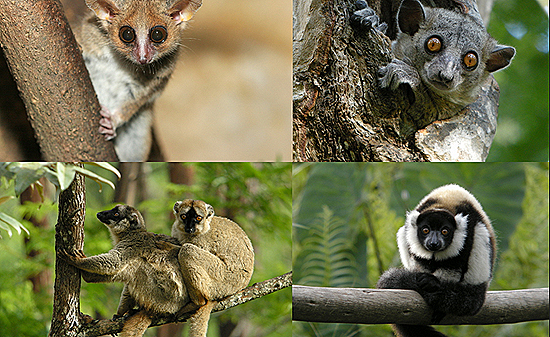
Lemurs are adorable. We've all seen the ring-tailed and ruffed lemurs basking in the sun at the zoo, and they're super cute. They are also just a couple of examples of the incredibly diverse range of species in the lemur family tree. There are many species you've probably never heard of or seen before. From teensy mouse lemurs to lemurs with freakishly long fingers, we're celebrating weird yet cute lemur species.
1. Brown mouse lemur
You're probably thinking there's no way this could be a lemur. It's got to be some sort of little squirrel or even a long-lost cousin of the sugar glider. But no, the brown mouse lemur is a primate and found only on Madagascar. The brown mouse lemur is nocturnal (hence the ridiculously huge eyes) and feeds on insects, fruits and flowers, including nectar and pollen. The species is the shortest lived of all the primates, making it only to about 6-8 years old. While it looks quite different from many other lemur species, it has one thing in common with all lemurs: it is vulnerable to extinction.
Suggested Stories: (1) 10 of the cutest endangered species; (2) 20 pygmy animal species from around the world.
2. Diademed sifaka
We go from one of the world's smallest to one of the world's largest lemur species. The diademed sifaka is a critically endangered lemur species native to a handful of rain forests in eastern Madagascar. The long white fur that circles its face is what gives it its name. Diademed sifakas live their lives primarily in the forest canopy, rarely coming to the ground. They are made for life above ground, with the ability to move as fast as 18 miles per hour through the trees using their strong legs for leaping. There are only between 6,000-10,000 individuals left of this colourful, unique lemur species.
Suggested Stories: (1) Weird little bats from Madagascar once much more common than they are today; (2) Endemic species: Top 9 lonely animals.
3. Aye-aye
If you're surprised to know the aye-aye is a lemur species, you're not alone - scientists argued about this until 2008 when the animal was grouped in with other families of species under the umbrella of lemurs, and the classification may shift again. But currently, we're going with lemur. The aye-aye is famous - or rather, infamous - for its creepy appearance. Despite its reputation for being an evil omen, the aye-aye is an incredibly cool animal. It's the world's largest nocturnal primate species. Because the aye aye is active when it's dark, it uses sound to find food, but not in the way you might think. Climbing along a tree, it taps the trunk and listens until it locates a grub under the bark. It then uses rodent-like teeth to gnaw a hole and uses its extremely long, thin fingers to fish insects out of the bark of trees. Basically, it's the primate version of a woodpecker. Unfortunately, it is also endangered, and its "evil omen" reputation doesn't help; many Malagasy people kill aye-ayes on sight and hang them up as a way to get rid of evil spirits.
Suggested Stories: (1) Can you name these weird animal species? (2) 21 animals with completely ridiculous names.
4. Mongoose lemur
The mongoose lemur is one of only two lemurs found outside of Madagascar, and it is an introduced resident of the Comoros Islands. Even with this extra real estate, it's still limited to a tiny area of Madagascar and is listed as a critically endangered species. It eats fruits, flowers and nectar, making it important for both pollination and seed dispersal. Rather than being diurnal, nocturnal or crepuscular like most animals, mongoose lemurs are cathemeral, meaning they're active at varying times of the day and night depending on the season and availability of light. Basically they're always ready to move it, move it. (You knew that "Madagascar" movie reference was coming at some point!)
Suggested Stories: (1) Locust swarms wreak havoc on Madagascar's farmlands; (2) 15 endangered species that are still on the menu.
5. Bamboo lemur
The bamboo lemur wasn't called that until the 1980s. Before that, it was known as the gentle lemur, which is ironic considering it is one of the most aggressive lemurs in captivity. (The "gentle lemur" name has to do with the Greek translation of the genus name, but that's a long story.) Anyway, they're now known as bamboo lemurs and there are five species and three subspecies, all found on Madagascar in forests where there is a lot of (you guessed it) bamboo and they eat primarily (you guessed it again) bamboo. One of these species, however, is entirely not like the others. The Lac Alaotra bamboo lemur lives in the reed beds of Lac Alaotra, rather than high in the forest canopy. Where most lemur species are poor swimmers, this species swims well thanks to spending a good deal of time in the water.
Suggested Stories: (1) 10 of the cutest endangered species; (2) 20 pygmy animal species from around the world.
6. Fork-marked lemur
If the brown mouse lemur reminded you even a smidgen of the sugar glider, then the fork-marked lemur looks like the sugar glider's twin! The species is named for the two dark stripes running over its face and head. Found in patches of forest on the north, west and east sides of Madagascar, they are among the least studied lemur, so not much is known about them. We do know, however, that they are nocturnal and get around by running along the lower branches of trees about 10 feet off the ground. They can leap quite a distance when moving from tree to tree, clearing as much as 15 feet horizontally or over 30 feet when leaping to lower branches. They eat mainly gums and saps from various tree species and also enjoy snacking on arthropods and sometimes even small reptiles, so their speed in the tree branches comes in handy mostly in territorial disputes.
Suggested Stories: (1) Weird little bats from Madagascar once much more common than they are today; (2) Endemic species: Top 9 lonely animals.
7. Blue-eyed black lemur
Winner of "best eyes" is the blue-eyed black lemur. It's a tiny bit of a misnomer because only the males are black; the females are a reddish-brown colour. Both colours help their striking blue eyes stand out. What's particularly amazing about this characteristic is that they are one of the only primates other than humans to consistently have blue eyes. But don't let those baby blues fool you into thinking this is a particularly sweet species. They're quite aggressive - they have skirmishes within their troop, and they will even commit infanticide against other lemur species when in captivity, a behaviour that is usually rare. However feisty they might be, they still haven't been able to fight their way out of trouble in the wild. Deforestation has driven this species to near extinction. Sadly the blue-eyed black lemur is now one of the 25 most endangered primate species in the world.
Suggested Stories: (1) Can you name these weird animal species? (2) 21 animals with completely ridiculous names.
8. Common brown lemur
We go from blue eyes to vibrantly orange eyes. The common brown lemur lives in a wide variety of forest types, from lowlands to mountains, from evergreen forests to deciduous forests. This range likely factors into its status as near threatened, rather than endangered or critically endangered like so many of its cousins. The common brown lemur is mostly active during the day but like the mongoose lemur, it can be cathemeral as well. In fact, these two species sometimes share territory, and adjusting the times of their activity helps them avoid conflict and peaceably divvy up the resources of their forest homes.
Suggested Stories: (1) Locust swarms wreak havoc on Madagascar's farmlands; (2) 15 endangered species that are still on the menu.
9. Golden-crowned sifaka
This lemur species looks like it was patted on the head by King Midas. It's all white or cream-coloured coat is topped with a crown of gold. Golden-crowned lemurs live in groups of five or six individuals, and females are the leaders. The only known predator is the foosa, but humans are increasing as a threat through habitat destruction and an increase in poaching for bushmeat. Only an estimated 18,000 individuals exist in the wild, living in 44 fragmented pieces of forest. They are listed as critically endangered.
Suggested Stories: (1) 10 of the cutest endangered species; (2) 20 pygmy animal species from around the world.
10. Silky sifaka
The long white fur of this species has a silky texture and along with its completely hairless face and ears, it is a real stand-out among lemur species. The males use a scent glad on their chest to mark the edges of their territory, and the resulting orange-coloured patch is the only easy way to tell males and females apart. Silky sifakas not only eat the usual leaves and seeds but also sometimes dine on something several other lemur species snack on: dirt. They can get some minerals and nutrients from eating clay and soils, a behaviour known as geophagy. Unfortunately, this species is also critically endangered, and is one of the 25 most endangered primates on Earth. There is no local taboo against eating this animal, so it is hunted throughout its remaining range, which has been significantly reduced through deforestation.
Suggested Stories: (1) Weird little bats from Madagascar once much more common than they are today; (2) Endemic species: Top 9 lonely animals.
Top image: Variety of lemurs, clockwise from top left: grey mouse lemur, red-tailed sportive lemur, red-fronted brown lemur, black-and-white ruffed lemur. Credit: Wikimedia Commons (cropped image).
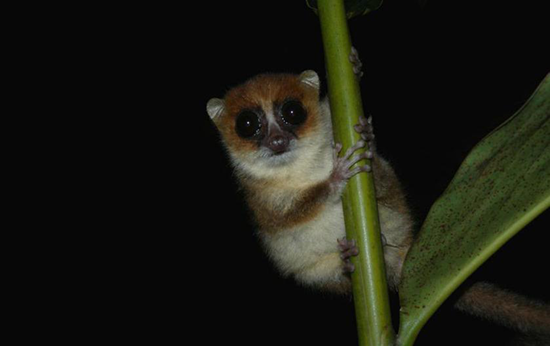
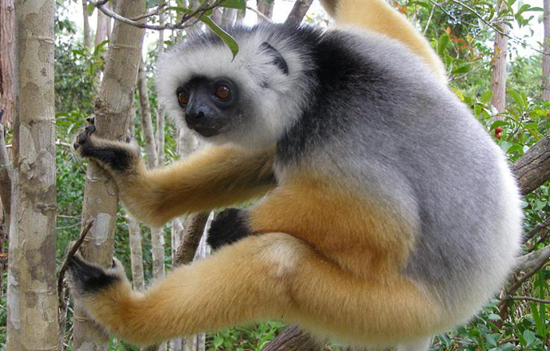


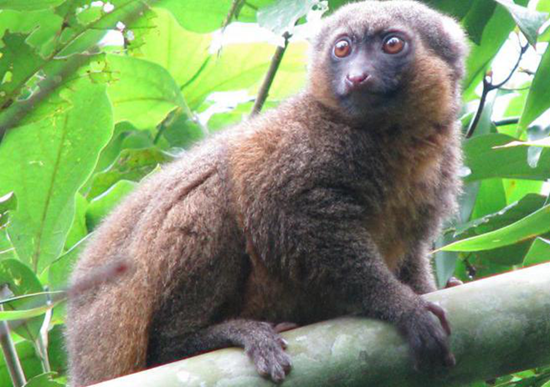
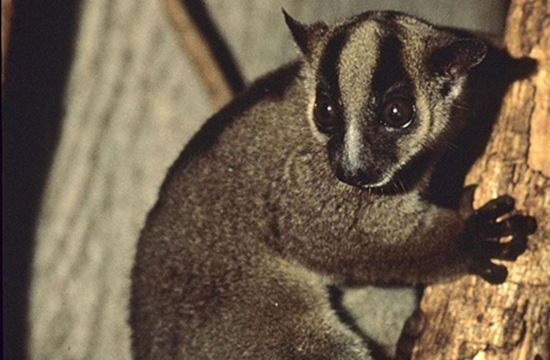

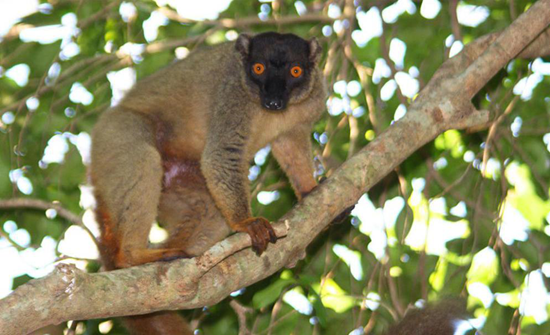
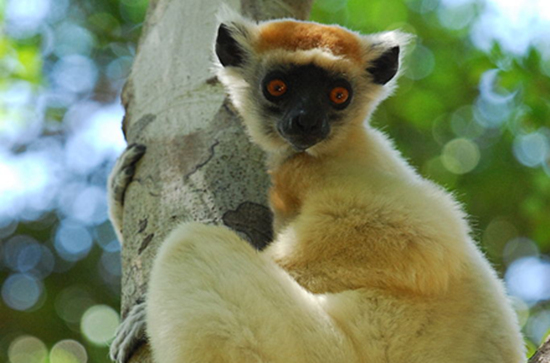
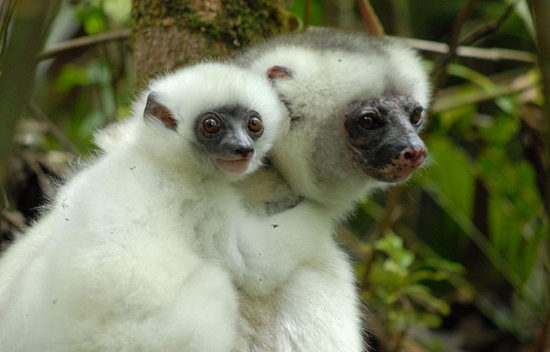
No comments:
Post a Comment
Please adhere to proper blog etiquette when posting your comments. This blog owner will exercise his absolution discretion in allowing or rejecting any comments that are deemed seditious, defamatory, libelous, racist, vulgar, insulting, and other remarks that exhibit similar characteristics. If you insist on using anonymous comments, please write your name or other IDs at the end of your message.